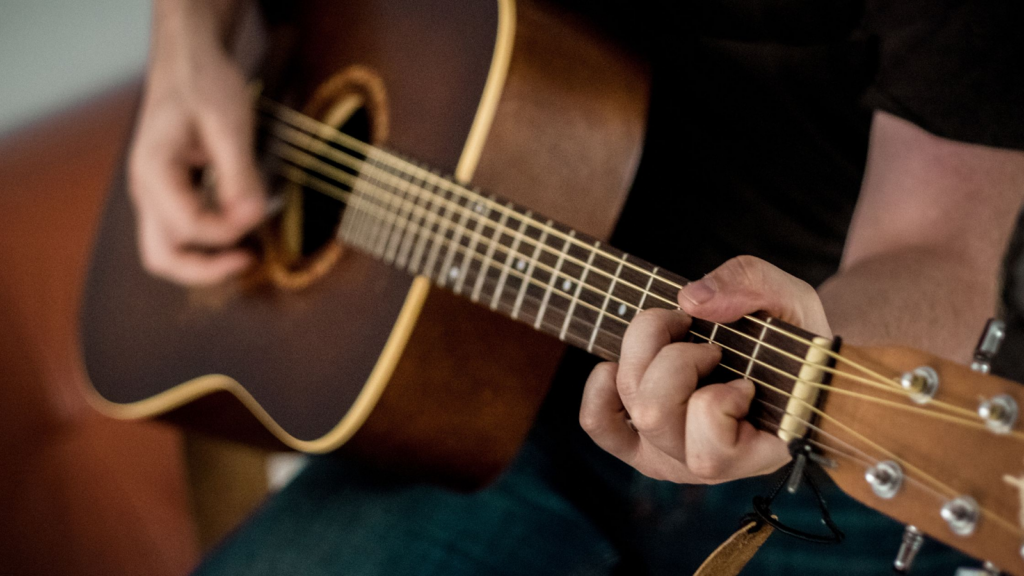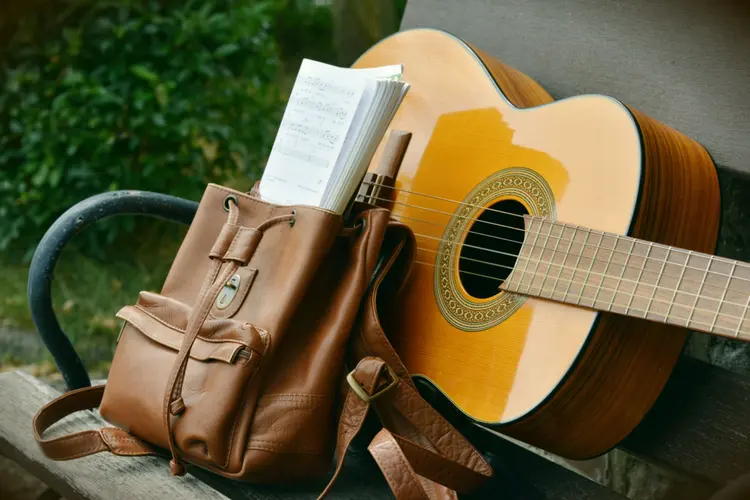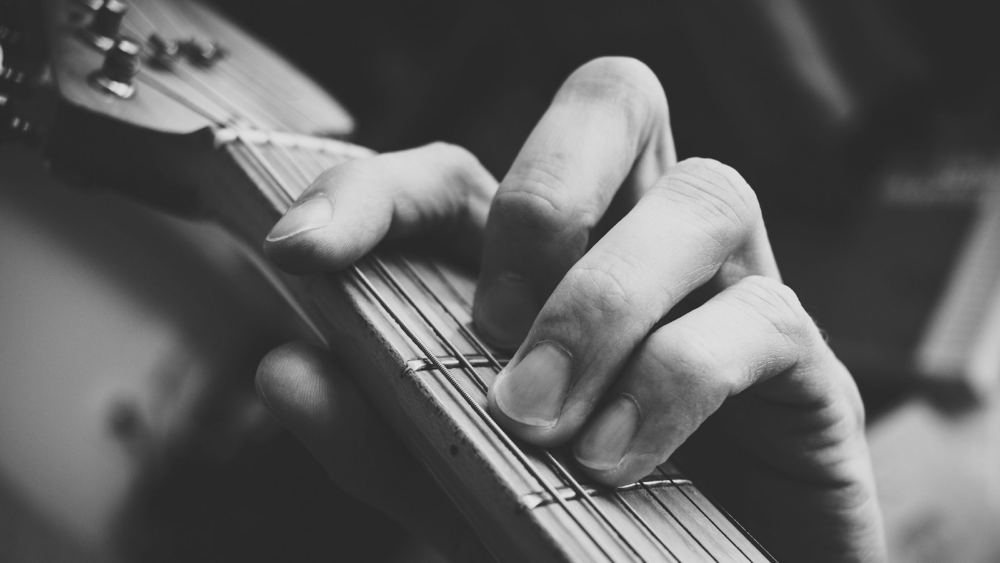The F chord on the guitar is often considered a rite of passage for beginner guitar players, whether you’re playing the electric or acoustic guitar. Its unique formation and sound make it an essential chord to master.
This article will show you how to play the F chord and its variations, helping you take your guitar playing to the next level.
Basics For Beginners: The Simple Chords You Need to Master And Why
When you’re starting your journey as a guitarist, mastering a few fundamental chords is the key to unlocking a world of music. Whether you’re playing two-chord songs, three-chord songs, or four-chord songs, these basic chords not only form the foundation of countless songs but also help you develop essential skills for more advanced playing.
Let’s explore some simple yet crucial chords that all guitar students need to master.
The Essential Open Chords
C Major Chord – The C major chord is one of the most common chords in Western music. It’s used in a vast array of songs and is fundamental to understanding chord progressions and music theory.
G Major Chord – The G chord is vibrant and resonant and only appears in many popular songs. It’s essential for learning how to transition between chords smoothly.
D Major Chord – The D major chord and its variations have a bright, uplifting sound. It’s often used in combination with G and C, forming a popular chord progression that’s useful for practicing rhythm and strumming patterns.
E Minor Chord – E minor is one of the easiest chords to play, making it a great starting point for beginners. It’s also pivotal for understanding minor tonalities.
A Minor Chord – A minor is a commonly used chord that adds a melancholic sound to progressions. It’s one of the best practice chords for finger dexterity and positioning.
Understanding the F Chord

The Basic F Chord Shape
The F chord is one of the harder chord shapes to master. It can be played in several ways, but let’s start with the basic form. This easier version involves this:
- Place your index finger on the 1st fret of the 2nd string.
- Place your middle finger on the 2nd fret of the 3rd string.
- Place your ring finger on the 3rd fret of the 4th string.
The F Barre Chord
A more advanced and fuller-sounding version is the F-barre chord. Here, you use your first finger to bar across the first fret, effectively holding down all strings at this fret. Your other fingers are then placed to form the complete chord shape.
The Difference Between F Chord and F Barre Chord
The key difference lies in the hand placement and the number of strings involved. The F barre chord requires barring all strings with the index finger, creating a more robust sound. In contrast, the basic F chord involves fewer strings and is generally easier for beginners. However, it doesn’t sound as full because of this.
Exploring Advanced Variations of the F Chord
There are many different advanced variations of the F chord for you to practice and master. Each variation not only adds a unique flavor to your music but also enhances your versatility as a guitarist.
Here are some advanced versions that can enrich your playing.
F Chord with Added Bass Notes
One way to give the F chord a richer sound is by adding bass notes. For instance, you can play a F/A chord, where the A note (the open 5th string) acts as the bass. This variation offers a more resonant and full-bodied sound, ideal for certain musical styles.
Suspended and Extended F Chords
Suspended and extended chords bring a unique character to the F chord. For instance, the Fsus2 or Fsus4 chords replace or add certain notes to the basic F chord, creating a sense of tension and release in your music. These chords are perfect for adding emotional depth to a song.
F Chord Inversions
Inversions of the F chord involve changing the order of the notes. For example, playing the C note (from the A string, third fret) as the lowest note results in a first inversion F major chord. Inversions are a great way to play the same chord but with a different sonic texture.
Using Different Fingerings
Exploring different fingerings for the F chord can also lead to discovering new sounds. For example, you can play the F major chord as a barre chord starting from the 8th fret of the A string. This version has a brighter, more jangly tone compared to the standard barre chord form.
F Chord with Added 7th
Adding a 7th to the F chord, like in Fmaj7, introduces a jazzier, more complex sound. This chord includes the E note, adding a layer of sophistication to the harmonic structure.
F Power Chords
For electric guitar players, particularly those into rock and metal, the F power chord offers a raw and powerful sound. This chord focuses on the root and fifth notes, delivering a punchy and direct tone, ideal for heavy riffs and rhythms.
Alternate Tunings
Playing the F chord in alternate tunings, like DADGAD or Open G, can yield fascinating results. These tunings allow for different voicings and resonances, giving a fresh perspective to the chord.
Capo Usage for F Chord Variations
Using a capo can change the sound and feel of the F chord dramatically. Placing a capo on different frets and playing the F chord shape will transpose the chord, allowing you to explore new sonic territories while maintaining familiar finger placements.

The Art of Mixing Chord Variations
The real art lies in knowing when to use these variations. It’s about matching the chord’s sound with the mood and style of the music. Experiment with these advanced versions in your playing and discover how each variation can uniquely contribute to your musical expression.
By mastering these advanced variations of the F chord, you will expand your musical vocabulary and open up new avenues for creative expression on the guitar.
Practical Tips for Mastering the F Chord
Mastering the F chord on the guitar can be a challenging yet rewarding endeavor. They don’t call it one of the “dreaded” chords for nothing. But, like with everything, all it takes is a bit of practice. Here are some detailed, practical tips that focus on technique, practice habits, and problem-solving strategies. These tips are designed to make your learning process more efficient and enjoyable.
Developing Effective Practice Routines
Start Slow and Build Up – Begin by practicing the F chord slowly, focusing on the accuracy of finger placement. Gradually increase your speed as you become more comfortable.
Regular Short Sessions – Instead of long, infrequent practice sessions, opt for shorter, more regular practice times. Consistency is key to building muscle memory.
Isolated Practice – Work on just the F chord initially before trying to incorporate it into progressions. This isolates the challenge and helps you focus on mastering the chord itself.
Refining Finger Placement and Pressure
Clear Note Production – Ensure each string rings clearly. If a string is buzzing, adjust the placement of your fingers slightly. This might involve rolling your finger slightly to use a firmer part of your fingertip.
Thumb Positioning – Your thumb should be positioned at the back of the guitar neck for the barre chord version. This position provides the necessary leverage for your fingers to press down the strings effectively.
Balanced Pressure – Apply consistent pressure across all strings. For the barre chord, ensure your index finger evenly presses down all the strings.
Transitioning Between Chords
Chord Changes – Practice transitioning from the F chord to other common chords, such as C, G, and Am. Start slowly and focus on smooth movements.
Anchor Fingers – Use fingers that stay in the same position between chord changes as ‘anchors.’ This can help in quicker and more accurate transitions.
Muscle Memory Development – Repeat chord transitions multiple times to develop muscle memory. This repetition is crucial for fluid chord changes.
Common Challenges and Solutions
Dealing with Finger Pain – Finger pain is common when learning barre chords. Take breaks and gradually increase your practice time to build strength and endurance.
Achieving Clean Sound – If you’re struggling to get a clean sound, focus on your finger pressure and positioning. Make sure each string rings clearly.
Overcoming the Difficulty of Barre Chords – Barre chords are challenging for many beginners. Start with partial barres and work your way up to full barre chords.
Engage with the Guitar Community – Join guitar forums and communities to share experiences, tips, and progress. Learning from others can be incredibly beneficial.
Additional Resources – Look for online tutorials, chord diagrams, and instructional videos to supplement your practice. Remember, the journey of learning guitar is as rewarding as the destination. Embrace each step, practice diligently, and soon, the F chord will be a natural part of your guitar repertoire.

Embracing the F Chord: A Journey of Musical Growth
Mastering the F chord on the guitar is a journey filled with challenges and triumphs. This chord, with its various shapes and sounds, is more than just a combination of notes; it’s a gateway to a richer musical expression. The journey from the initial struggles with finger placements and barre pressure to smoothly transitioning into and out of the F chord is a testament to your dedication and love for guitar playing.
As you incorporate the tips and techniques outlined in this article, remember that patience and consistent practice are your most valuable tools. Each practice session, no matter how small, brings you one step closer to mastering this essential chord. Embrace the learning process, and celebrate your progress. Never hesitate to seek help or guidance from the vast guitar-playing community and the resources available.
So, pick up your guitar, tune those strings, and let the sweet sound of the F chord ring out. Your musical adventure awaits, and the F chord is just the beginning. Happy playing!


